MR Safety
Digital Poster
MR Safety
4151 -4175 Simulating RF Safety & SAR
4176 -4200 RF & Gradient Safety Methods
Simulating RF Safety & SAR
Digital Poster
Digital Poster
MR Safety
Wednesday, 15 May 2019
| Exhibition Hall | 15:45 - 16:45 |
| Computer # | |||
4151. 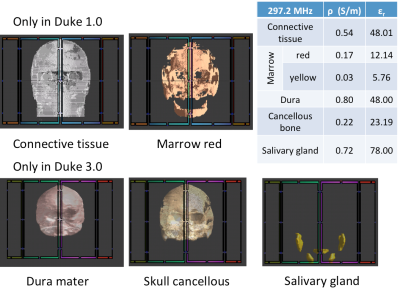 |
126 | Parallel transmit RF safety simulation: effects of differences in tissue compartmentsbetween different voxel models
Hongbae Jeong, Peter Jezzard, Aaron Hess
In this study, we demonstrate the effects on RF simulation from subtly different tissue compartments in the same morphometric space. We evaluate this by using two well-characterised electromagnetic models, Duke versions 1.0 and 3.0. Maps of 10g SAR across a range of B1+ shims were evaluated, showing uncertainties arising from segmentation differences. By using a dedicated voxel model, an increased confidence in electromagnetic simulation can be achieved.
|
|
 |
4152. 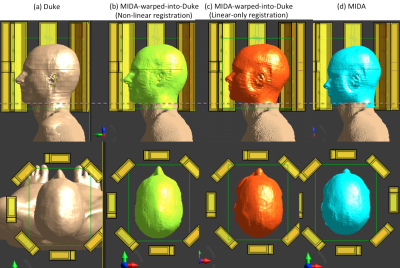 |
127 | Feasibility of personalized RF safety monitoring in pTx MRI using linear registration versus non-linear registration
Hongbae Jeong, Jesper Andersson, Aaron Hess, Peter Jezzard
In this study, we demonstrate the feasibility of personalised RF safety monitoring in pTx MRI using linear registration versus non-linear registration. We evaluate this by using two well-characterised models, Duke, and MIDA. An 8-channel dipole array was used to evaluate maps of 10g averaged SAR across a range of B1+ shims, showing potential utility of linear registration (rotation, scaling, skew, translation). Our study shows that both linear registration and non-linear registration can be used to monitor SAR in pTx MRI to reduce the safety margin arising from differences in patient head position, shape and size.
|
4153. 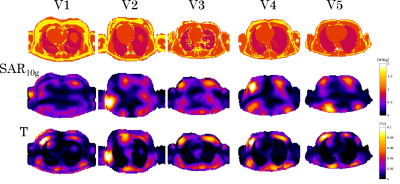 |
128 | SAR and temperature distributions in a database of realistic human models for 7T cardiac imaging
Bart Steensma, Ettore Meliado, Erik Huijing, Peter Luijten, Dennis Klomp, Cornelis van den Berg, Alexander Raaijmakers
A database of 10 realistic human models was generated to study inter-subject local SAR variation for a 7T cardiac coil array. 10 volunteers were scanned at 1.5T after which DIXON imaging data was segmented in five tissue types. SAR and temperature rise were simulated for these models and 10,000 random phase settings. With 99.9% confidence the local SAR levels will not surpass 3.32 W/kg for 8x1 W input power and after 6 minutes of exposure, the maximum temperature rise is 0.19 °C (99.9% confidence). For 20 seconds of exposure (long
|
|
4154. 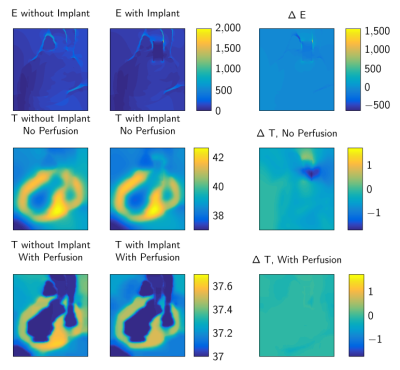 |
129 | Assessment of the Alleviating Impact of Perfusion on RF-induced Heating due to Artificial Cardiac Valves
Peter Stijnman, Bastiaan van Nierop, Janot Tokaya, Peter Luijten, Josien Pluim, Cornelis van den Berg, Alexander Raaijmakers
Artificial cardiac valves or stents can cause
|
|
4155. 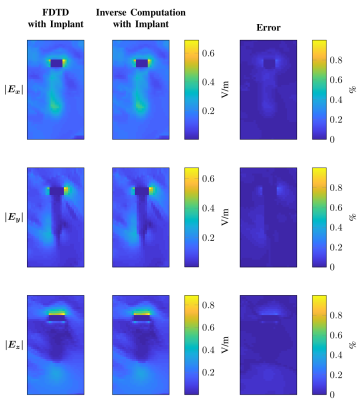 |
130 | Calculation of the scattered RF field around implants within seconds using a low-rank inverse updating method
Peter Stijnman, Janot Tokaya, Jeroen van Gemert, Peter Luijten, Josien Pluim, Wyger Brink, Rob Remis, Cornelis van den Berg, Alexander Raaijmakers
Scanning patients that have metallic implants may cause tissue heating. This heating is quantified with electromagnetic simulations. We present an alternative method to quickly compute the electromagnetic response of implants by reducing the problem size using a low-rank inverse updating method. This method requires a pre-computed library of field responses at possible implant locations. Results show computed RF fields that are completely equivalent to full-wave simulations while being 1500 times faster. In particular, computations involving small geometric alterations become faster. This method facilitates rapid field computations and possibly enables online RF- or tier 4 ISO/TS 10974 safety assessment.
|
|
4156.  |
131 | Simplified subject-based models for efficient electromagnetic simulations and evaluation of local SAR for 7 T abdominal MRI
Emma Doran, Stephen Bawden, Richard Bowtell, Penny Gowland, Paul Glover
We investigated the required detail of human body models for Fdtd simulations of a multi-transmit eight-channel body array used for abdominal imaging at UHF. The effect of reducing the number of tissue types on local 10 g averaged SAR (SAR10g,av), B1+ and coil scattering matrices (S-matrices) was investigated on subject-based manually segmented models. Models that differentiate between the lungs, fat, muscle and skin tissue were found to be sufficient to recreate results produced in fully segmented models. This finding was used to implement segmentations of 3 T mDIXON images of subjects to generate subject-specific models for Fdtd simulations efficiently.
|
|
4157. 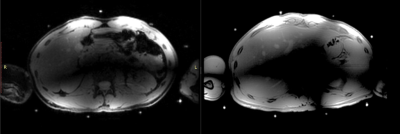 |
132 | Repeatability of FDTD simulations for determining local SAR and B1+ distributions for UHF abdominal imaging.
Emma Doran, Stephen Bawden, Richard Bowtell, Penny Gowland, Paul Glover
This study assessed the repeatability of FDTD simulations used to calculate local specific absorption rate (SAR) and B1+ distributions for abdominal imaging on a 7T (UHF) parallel transmit (pTx) system when subjected to typical small displacements of the an eight channel transmit dipole body array experienced when repositioning subjects. Simulations were repeated on two subject-based models and the maximum local 10g averaged SAR (SAR10g,av), B1+ distributions and scattering matrices (S-matrices) were compared to assess variation. The consequences that this has for MR safety, RF shimming and coil loading is discussed.
|
|
4158. 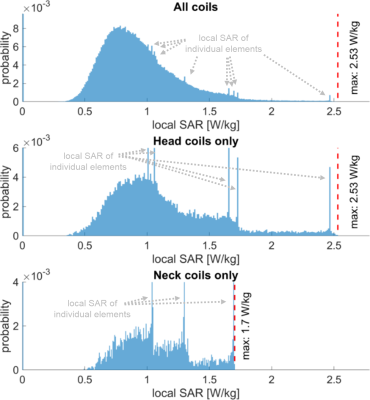 |
133 | Random RF Shimming may conceal possible local SAR hotspots for asymmetric parallel transmit coils
Emre Kopanoglu, Mohamed Tachrount, Ettore Meliado, Dennis Klomp, John Evans, Richard Wise
While general-purpose pTx coils mostly have identical elements arranged symmetrically, coils built for a specific application may be asymmetrical. This asymmetry may lead to a high variation in local SAR distributions of individual coil-elements. For an arterial spin labelling pTx coil, we show that using 2,000,000 unconstrained random excitations to characterize the maximum local-SAR underestimates the local-SAR by 7%. We also show that for the investigated ASL coil, the neck elements, which could be exclusively used for labelling, yield 33% less SAR than the head-imaging coils. Therefore, 50% higher power limits can be used for labelling part of an ASL sequence than the imaging part.
|
|
4159. 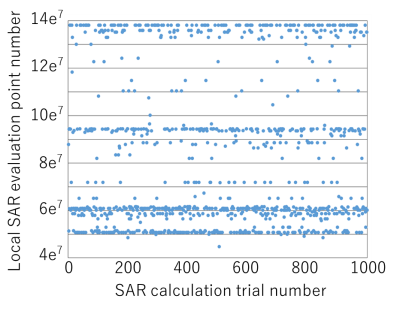 |
134 | An estimation method for maximum local SAR with evaluation points selected by iterative SAR calculation under a restricted random condition
Takafumi Ohishi, Koji Akita
This paper proposes an estimation method for maximum local SAR in parallel transmission. In order to estimate maximum local SAR with fewer evaluation points, the evaluation points are selected by iterative SAR calculation under a restricted random initial input signal condition. It is shown
|
|
4160. 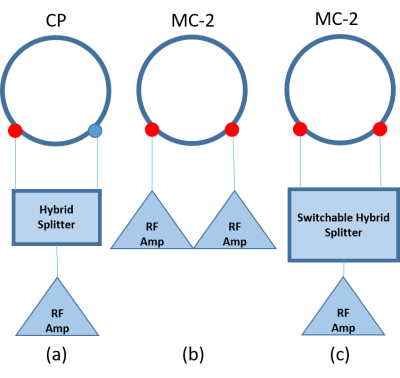 |
135 | B1+ Peak Based on Transmit Technologies and the Impact of Associated E Fields on AIMD MR RF Safety
Xin Huang, Xi Lin Chen, Shiloh Sison
Circular polarization (CP), Linear Polarization (LP) and Multi-Channel-N (MC-N) are RF transmit technologies at 3T. The B1+ peak limit is dependent on the RF coil amplifier topology and the transmit scheme. This may lead to significant changes in the induced E field in a patient and affect the MR safety assessment for active implantable medical devices (AIMDs). This abstract shows that even though B1+ peak levels of LP is lower than that of CP or MC-N, the E-field along an implant during LP can exceed CP or MC-N. Therefore, since LP can be achieved within CP or MC-N, it should be considered for AIMD MR safety assessment.
|
|
4161. 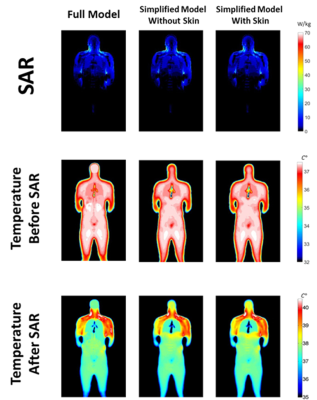 |
136 | Temperature-based MRI safety assessment with a simplified body model
Giuseppe Carluccio, Can Akgun, John Vaughan, Christopher Collins
The shape of the patient affects the distribution of the electromagnetic fields used in MRI. Therefore, it is important to run simulations on body models similar to the shape of the patient. While it was previously shown that a simplified model obtained with automatic segmentation tools could be used to perform a safety assessment based on SAR, we investigate through numerical simulations the possibility to perform temperature-safety assessment with a simplified model. We compare the results obtained with a detailed model comprising 35 tissues, one with 3 tissues (lungs, muscle, fat), and one with 4 tissues (lungs, muscle, fat, skin).
|
|
4162.  |
137 | The effect of tissue detail in pregnant body models on local SAR prediction accuracy at 3 T
Filiz Yetisir, Esra Abaci Turk, P Ellen Grant, Lawrence L Wald, Elfar Adalsteinsson
Generating fully detailed electromagnetic body models requires acquisition and segmentation of high-resolution MR images which is particularly difficult in pregnancy due to motion and intolerance of long scan times. However, to explore fetal and maternal RF safety at 3 Tesla with both the standard mode and parallel RF transmission, a variety of pregnant body models are needed. We assess the effects of using simplified versions of 6 pregnant body models on predicting the maternal and fetal peak local SAR. We find that the simplified models under/over-estimate the peak local SAR of fully detailed models by at most 23%/16%.
|
|
4163. 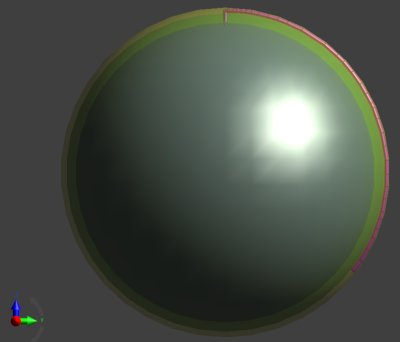 |
138 | RF heating of an intracranial pressure sensor in a 64 MHz head-only RF coil: a simulation study
Saghar Batebi, Blaine Chronik
Heating of implanted medical devices is a well-known hazard in MRI. We evaluated a device which represents an intracranial pressure sensor device, in which a catheter would be inserted into the cranium while the remainder of the catheter and device would be outside the skull, possibly under the skin. The device was modeled as a PEC with a fixed length and was positioned with a variable amount of the lead within the brain and exposure to a 64 MHz head-only RF coil. We found the heating is highest when the amount of the lead within the brain is minimized.
|
|
4164. 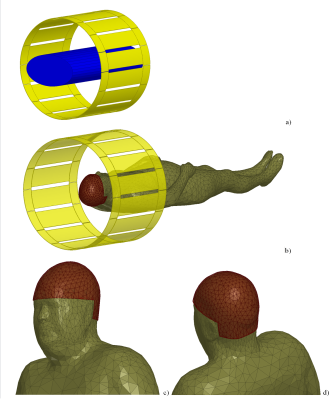 |
139 | RF Safety of EEG gel during MRI: a case study
Mikhail Kozlov, Nikolaus Weiskopf, Harald Möller
We evaluated the influences of the EEG gel on RF safety assessment of a 3T whole body scanner with a human subject located at a head landmark position. Our case study, which was performed assuming realistic conditions that may occur with commercially available equipment, provides evidence that the EEG gel “helmet” has an impact on head SAR during 3T MRI for a patient positioned at the head landmark position. A workaround for safe simultaneous EEG-MRI investigations might involve limiting the maximum transmit voltage at a lower level than that allowed by the scanner’s SAR supervision system (i.e. that for a given patient without EEG gel “helmet”).
|
|
4165. 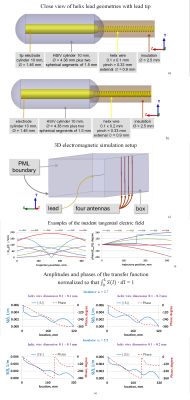 |
140 | Effect of helix wire geometry and insulator electrical properties on RF-induced temperature rise and the lead electromagnetic model: a case study
Mikhail Kozlov, Wolfgang Kainz
This case study we investigated RF-induced heating of different helix leads at 127.7 MHz obtained with the lead electromagnetic model (LEM) and direct 3D electromagnetic and thermal co-simulations. A large set of incident electric fields was generated in a phantom by an array of four antennas with varying spatial positions and sources. LEM was validated for predicting temperature in close proximity to the end face of lead tip. However the variance of the fitted values and observed values was rather high for the integral of the power deposition calculated over volume surrounded the lead tip.
|
|
4166. 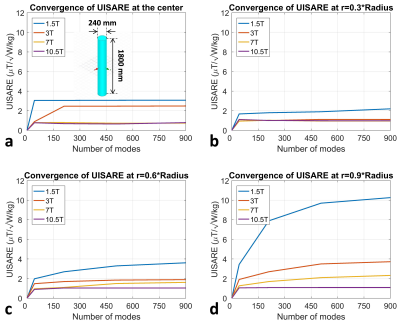 |
141 | Ultimate Intrinsic Specific Absorption Rate Efficiency
Alireza Sadeghi-Tarakameh, Xiaoping Wu, Firdevs Ulus, Yigitcan Eryaman, Ergin Atalar
Peak local specific absorption rate (SAR) is a limiting factor for many high and ultrahigh field MRI applications. Therefore, improving the SAR performance of the transmitters is the scope of many studies. In this study, we used the SAR efficiency (B1+/sqrt(peak local SAR)) as a metric to evaluate the SAR performance of transmitters and investigated its upper bound, defined as Ultimate Intrinsic SAR Efficiency (
|
|
4167. 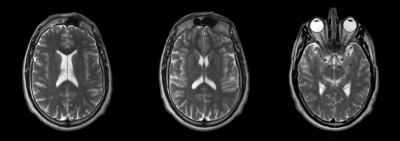 |
142 | Specific Absorption Rate in Head-Only Mid-Field Scanner: Comparisons to 1.5 T and 3 T
Ian Connell, Alex Panther, Blaine Chronik
The mid-field system studied here demonstrates reduced maximum 10-g SAR when performing RF excitation around resonant lead lengths as well as a total reduction in SAR consistent with SAR α Bo2. In comparison to 1.5 T and 3 T clinical scanners, mid-field scanners provide unique opportunities to obtain diagnostically relevant information with a commensurate increase in safety for patients with implanted devices.
|
|
4168. 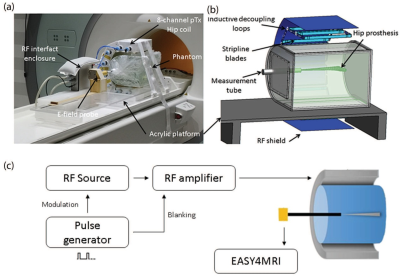 |
143 | Optimisation and validation of numerical simulation methods for parallel-transmit MRI near a hip implant at 7T
Aurelien Destruel, Ewald Weber, Kieran O'Brien, Feng Liu, Markus Barth, Stuart Crozier
Electromagnetic simulations are commonly used at 7T to predict and limit RF heating when pTx techniques are used. Correction of simulation results based on measured B1-maps and MR thermometry data have been shown to improve the simulation results, but may be affected by the presence of metal implants. In this work, B1-mapping and direct measurement of E-fields are used to validate simulation results of a pTx hip coil in the presence of a hip implant in a phantom. B1-data and/or E-field data were used and compared to correct simulation results.
|
|
4169. 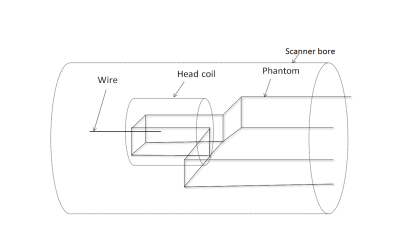 |
144 | RF heating asymmetry in the implants placed at opposite lateral halves of the ASTM phantom
Bhumi Bhusal, Tanvir Baig, Pallab Bhattacharyya, Stephen Jones, Michael Martens
The rectangular shape of ASTM phantom may result into asymmetry in heating when an implant is placed symmetrically on the left and right lateral half of the phantom. In this work, we study the RF induced heating at the tip of a long insulated implant partially immersed into the crown of an ASTM phantom through two opposite lateral halves. The position of the wire on the left and right halves are symmetrical about the central sagittal plane. The results show that the RF heating of an implant is 2-3 times higher at left than at right half of phantom.
|
|
4170. 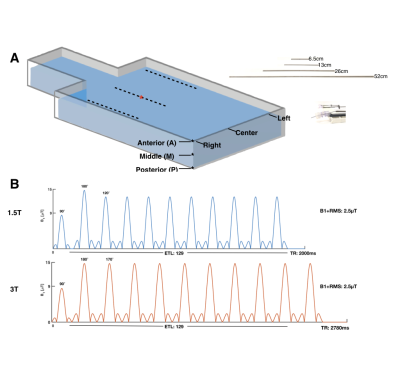 |
145 | A Comparison of RF-Induced Heating for a Range of Titanium Rods at 1.5T and 3T
Jessica Martinez, Kevin Moulin, Daniel Ennis
RF induced heating is a principal concern for patients with active implantable medical devices (AIMDs). MRI exams at >1.5T are often avoided, largely because the SAR increases with the square of field strength, thus RF-induced heating is expected to increase. RF induced heating, however, also arises because of the antennae-like characteristics of the AIMD. Our objective was to compare RF-induced heating in rods with different lengths at 1.5T and 3T when the same B1+RMS was applied. Results suggest that for a specific device length, RF-induced heating is not always higher for increasing field strength.
|
|
4171. 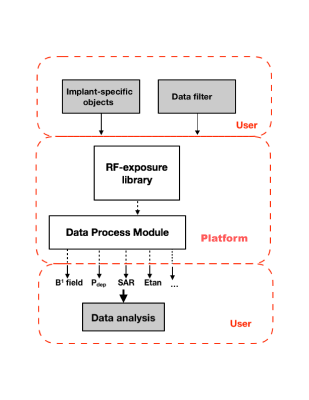 |
146 | Standardized, Validated and Effective Safety Assessment of Patients with Medical Implants under MRI Exposure Using a Comprehensive Data Library Combined with an Analytics Toolset
Aiping Yao, Earl Zastrow, Niels Kuster
The radiofrequency (RF) induced heating for patients with implants during exposure to magnetic resonance imaging (MRI) is a complex function of multiple factors, e.g., implant characteristic, patient anatomy, imaging position, RF coil, etc. A comprehensive safety assessment cannot be derived from the limited scenarios possible in clinical trials. We have established an in silico safety assessment trial that comprises a comprehensive data library with a data analytics toolset to perform a complete evaluation in a timely and traceable manner. We demonstrate the workflow for RF-induced heating evaluation for patients with medical implants.
|
|
4172. 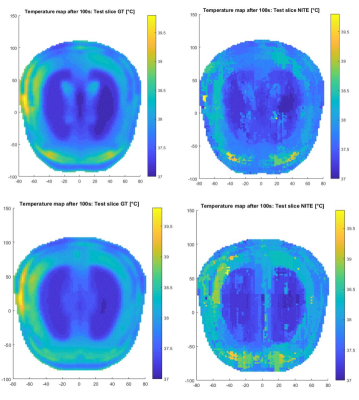 |
147 | Body temperature assessment through deep learning: the Non-Invasive Temperature Estimation (NITE) method
Julie Kabil, Sairam Geethanath, J. Vaughan
Heating risks may prevent a patient from receiving an optimal scan. A novel method of internal temperature prediction is proposed by training a neural network on a temperature map from a simulated brain slice, and testing on two other structurally different brain slices. The features are the tissues properties, distance to surface sensors, surface temperatures. The network provides similar maps compared to simulated maps. Current and ongoing work includes optimizing the network parameters to balance the accuracy of predicted temperature with the ability to generalize for the brain anatomy. Future work involves training on two models and testing on others.
|
|
4173. 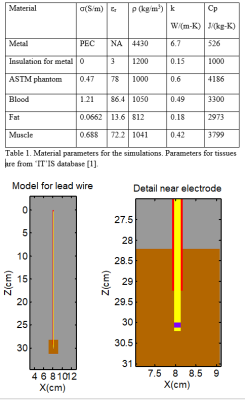 |
148 | Impact of different materials along the lead body and at the electrode on temperature rise at the electrode of an active implant
John Nyenhuis, Krishna Singhal
Temperature rise, scaled to the square of
|
|
4174. 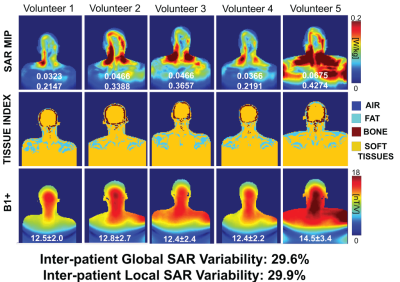 |
149 | Individualized SAR Calculations Using Computer-Vision-Based MR Segmentation and a Fast Electromagnetic Solver
Eugene Milshteyn, Georgy Guryev, Angel Torrado-Carvajal, Elfar Adalsteinsson, Jacob White, Lawrence Wald, Bastien Guerin
Current local specific absorption rate (SAR) calculations with offline simulated body models yield conservative safety limits on parallel transmission protocols. By using a personalized medicine approach, whereby the patient-specific body model is generated as the patient lies on the table, more accurate safety limits can be employed. In this study, we developed a fast methodology to scan the patient, segment the body, and calculate the global and local SAR. Our results from multiple volunteer scans show a 30% variation in local SAR, indicating the need for a patient-specific approach.
|
|
4175. 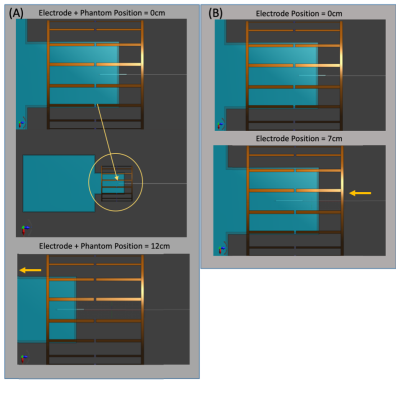 |
150 | RF-induced heating in the vicinity of human depth intracranial EEG electrodes: effect of electrode and implantation simplification on computational EM simulations
Hassan Hawsawi, Ozlem Ipek, David Carmichael, Louis Lemieux
Empirical assessments on phantoms are essential to assess the health risks associated with performing EEG recordings concurrently with fMRI in humans; however they are time consuming limiting our capability to adequately investigate the range of scenarios encountered in real-world applications. Electromagnetic (EM) computational simulations can help to address this limitation, if they can be performed efficiently enough. Here we assessed the improvements of computational efficiency obtained by simplifying the representation of brain-indwelling EEG electrodes for EM simulations. The observed differences in estimated SAR between the full and simplified models can be understood in terms of a simple heuristic model.
|
RF & Gradient Safety Methods
Digital Poster
Digital Poster
MR Safety
Wednesday, 15 May 2019
| Exhibition Hall | 15:45 - 16:45 |
| Computer # | |||
 |
4176. 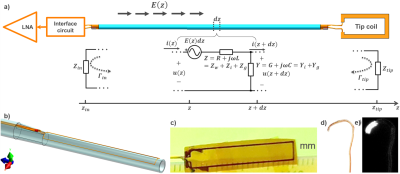 |
151 | Safety of active catheters in MRI: Termination impedance versus RF-induced heating
Ali Özen, Thomas Lottner, Michael Bock
To assess the MR safety of an active catheter, the interaction of an arbitrary E-field with an isolated transmission line was modeled analytically in cascaded lossy media. The catheter tip SAR was calculated for different E field configurations and termination impedances that were controlled by an input impedance unit integrated into the receiver interface circuit. Results of the analytical calculations were compared to transfer function (TF) measurements, and found to be in good agreement. By adjusting the input impedance, SAR at the tip of an active catheter could be reduced by 95%.
|
4177. 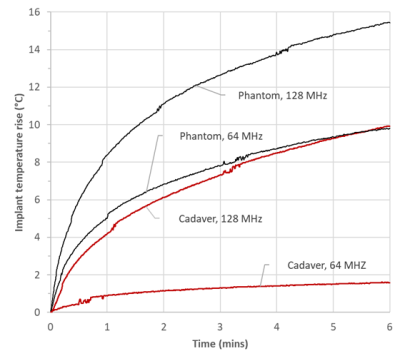 |
152 | Initial comparison of RF-induced heating in the ASTM phantom and a cadaver leg: a pilot study
Amgad Louka, Krzysztof Wawrzyn, Alan Getgood, Timothy Burkhart, William Handler, Blaine Chronik
The current standard for measurement of RF-induced heating for implanted devices is described in ASTM F2182-11a, however this method represents a highly conservative situation (i.e. higher than expected heating). Here we present a pilot cadaveric study investigating the relationship between heating of a standard device (10-cm Ti rod) placed within the ASTM phantom versus a cadaveric leg. At 64 MHz and 128 MHz, the respective implant heating in the cadaver was 1.57 and 9.87 °C, compared to 9.81 and 15.4 °C in the phantom. These results suggest a large margin between heating in the ASTM phantom and heating in-vivo.
|
|
4178. 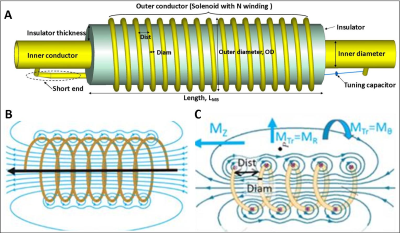 |
153 | Mitigating heating risk for long active metallic-backbone or metallic-braided cardiovascular devices using miniaturized Baluns (MBaluns): Design parameters, heating tests, and swine validation
Akbar Alipour, Eric Meyer, Wolfgang Loew, Ronald Watkins, Hassan Elahi, Aravindan Kolandaivelu, Susumo Tao, Michael Guttman, Jeff Schweitzer, Gregory Olson, Henry Halperin, Ehud Schmidt
Long (>wavelength/4) actively-tracked metallic-backbone or metallic-braided cardiovascular devices are not used in MRI-guided interventions due to surrounding-tissue heating concerns. Such devices may be used if induced currents on the metallic-backbone and internal cables are sufficiently attenuated. At ISMRM 2018 we demonstrated a miniaturized resonant floating Balun (MBalun), and two actively-tracked MRI-guided metallic interventional devices built using MBaluns. MBaluns were constructed with loosely-wound solenoids overlaid on the metallic-backbones, generating strong transverse magnetic fields that attenuated surface currents and internal-cable common-mode currents. We now provide electromagnetic simulation revealing MBalun critical dimensions, along with phantom heating and swine experiments that validate the designs.
|
|
4179. 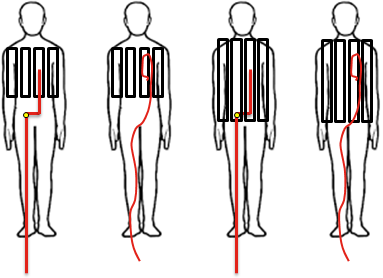 |
154 | Planning Current Nulling for Worst Case SAR reduction in a Cardiac Guidewire Scenario at 1.5T
J. Nuno Teixeira, Felipe Godinez, Shaihan Malik, Joseph V. Hajnal
Interventional MRI using long conductive guidewires, risks high Local SAR and reduced image quality. This work expands on previous work relating current ‘nulling’ techniques to reducing worst case SAR, by investigating the importance of wire placement and current sensing planning. Results showed that two very distinct wires displayed common features but differences in behaviour do not allow for a generic ‘nulling’ plan. Also, there is a trade-off between removing current-generating modes, and reducing B1+ efficiency that subsequently increases RF power to achieve necessary image quality. Overall, a careful study of the system can help find the optimal ‘nulling’ plan.
|
|
4180. 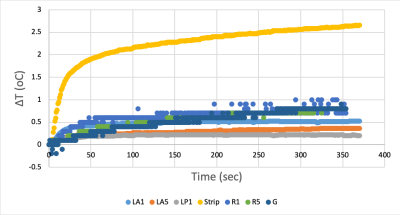 |
155 | Concurrent scalp and intracranial electroencephalography recording in a human 1.5T MRI scanner: RF-induced heating assessment
Hassan Hawsawi, Anastasia Papadaki, Vejay Vakharia, John Thornton, David Carmichael, Louis Lemieux
The acquisition of electroencephalography (EEG) concurrently with functional magnetic resonance imaging (fMRI) requires careful consideration of the health hazards resulting from interactions between the scanner’s electromagnetic fields and EEG recording equipment. with excessive RF-induced heating near the electrodes being the main one. In view of performing concurrent scalp and intracranial EEG-MRI, we measured heating in the vicinity of electrodes placed within and on a phantom during high-SAR sequences in two conditions: with intracranial electrodes only, and following the addition of scalp electrodes. Temperature variations were well within the safety guidelines at all measurement locations in both conditions.
|
|
4181. 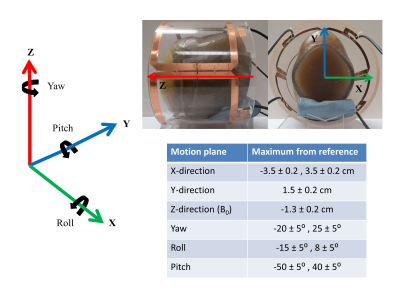 |
156 | Parallel RF Transmission for Safe 3 T MRI of Deep Brain Stimulation Devices: Effect of Mis-positioned Suppression Mode
Benson Yang, Pei-Shan Wei, Simon Graham
Magnetic resonance imaging (MRI) offers many benefits for deep brain stimulation (DBS) patients. However, radiofrequency (RF) heating remains a concern for MRI at 3T. Parallel transmission technology (pTx) has the potential to lower the risk by generating low electric-field regions at target locations. As pTx technology proceeds to imaging DBS patient, the impact of head motion becomes an important consideration. The present study investigates the impact of phantom mis-positioning when using pTx technology to suppress RF heating with results indicating head motion can potentially cause unsafe temperature elevations.
|
|
4182. 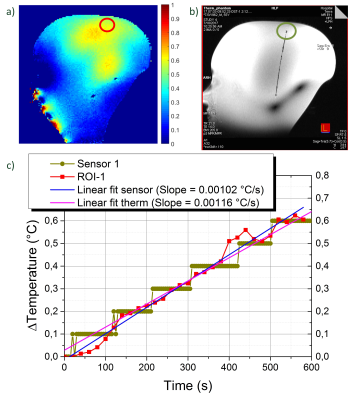 |
157 | Determination of local SAR through MR Thermometry at 7T
Ignacio Gonzalez Insua, Rene Gumbrecht, Karsten Wicklow, Jonathan Polimeni
MR thermometry at 7T allows the straight forward acquisition of temperature maps with very high spatio-temporal resolution. This sensitive method at ultra high fields (UHF) allows the acquisition of local SAR distribution in a tissue equivalent gel head phantom. Using a 1mm isotropic resolution, 5s sampling rate and <0.04°C accuracy in temperature we are able to assess the MR safety of RF coils and validate the underlying electromagnetic and thermal simulations.
|
|
4183. 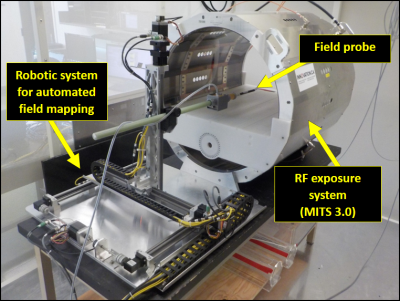 |
158 | Comparison of Simulated and Robotically Mapped RF Fields in 64 and 128 MHz Medical Implant Test Systems
Krzysztof Wawrzyn, Jack Hendriks, Dereck Gignac, William Handler, Blaine Chronik
In this work we demonstrate a procedure for the use of a custom-built, semi-automated robotic positioning system to map EM fields in commercially available RF exposure systems and compare the results against FDTD simulations. All field measurements were obtained independently with calibrated E-field or H-field probes. Results show that the robot can effectively operate within the complicated EM environment of the RF exposure platforms with good agreement between simulated and measured results. Future work will continue to improve the techniques discussed here.
|
|
4184. 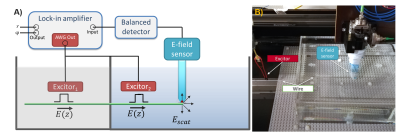 |
159 | Safety Assessments in the Cascaded Media Using an Electro-optic Sensor-based Transfer Function Measurement Setup
Ali Özen, Thomas Lottner, Simon Reiss, Andreas Bitzer, Michael Bock
MR safety evaluations of metallic implants/devices are performed in single homogeneous media. However, most of the implants/devices function in different media interfaces such as DBS and iEEG electrodes, catheters, biopsy needles…, etc. Loading of the conducting lines change drastically inside media with different dielectric properties, so does the RF-induced heating characteristics. To improve in vitro MR safety evaluations, we introduce a new TF measurement setup that allows safety evaluations in cascaded media (CM). The performance of the CM-TF setup was verified on isolated and bare lead wires immersed in air/tissue-simulating-medium interface by comparing to FDTD simulations and analytical models.
|
|
4185. 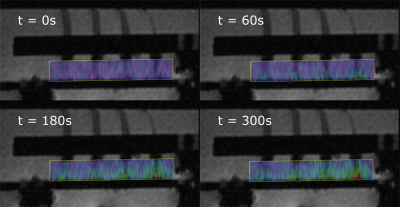 |
160 | Avoiding Systematic Errors of Fiber-optic Temperature Probes: MR Thermometry for Safety Assessment of Small Planar Metallic Structures
Thomas Lottner, Johannes Erhardt, Andreas Reichert, Ali Özen, Lars Bielak, Martin Schuettler, Michael Bock
Patients with AMIDs are exposed to a significant safety hazard during MRI, as the RF excitation couples to the elongated metallic structures of the AIMD resulting in an unwanted heating of tissue. Temperature measurements are the standard method for heating tests of implants to ensure patient safety during MRI exams. Temperature sensors with a significant size compared to the samples influence the RF absorption of energy and can distort the temperature distribution. MR thermometry can provide a non-invasive 2D alternative.
|
|
4186. 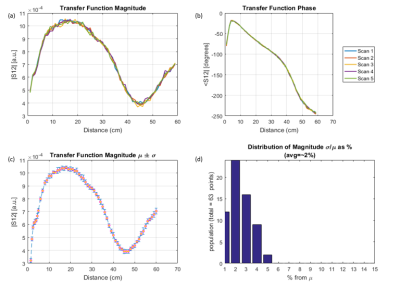 |
161 | Repeatability of measured RF transfer functions of IPG and lead based AIMD systems
Carolyn Kwok, Mizan Rahman, Ross Venook, Louai Aldayeh
Lead heating and malfunction of implantable medical devices, such as Spinal Cord or Deep Brain Stimulators, due to MRI RF field exposure are patient safety concerns. The transfer function is a method used to calculate predictions of MRI-induced heating or injection voltages. This study investigated the repeatability of a measurement-based transfer function system. Results showed that the inherent variation of the system can be minimal, whereas lead positioning in the system has a higher impact on variation.
|
|
4187.  |
162 | Superadditive RF Heating in Gaps between Two Metallic Implants
Manuel Murbach, Esra Neufeld, Ilaria Liorni, Niels Kuster
The test method for safety assessment with regard to radiofrequency (RF) heating of small metallic medical implants in MRI is standardized by ASTM. However, the focus lies on individual or electrically connected implant systems whereas, the none-electrically connected combination of multiple adjacent implants has not yet been sufficiently investigated and may lead to considerably altered RF coupling. In this study, we assessed induced heating as a function of the separation distance between two orthopedic metallic implants. Results show that the strong coupling between two short implants may lead to even higher temperature increases than that of a single implant of the combined length.
|
|
4188. 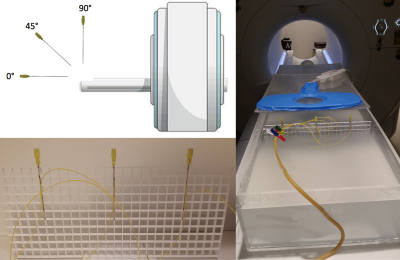 |
163 | Radiofrequency Heating of MR-conditional Needles during Interventional Magnetic Resonance Imaging at 1.5 and 3 Tesla Field Strengths
Iman Khodarahmi, Luke Bonham, Clifford Weiss, Jan Fritz
MR conditional 10, 15 and 20 cm cobalt chromium needles pose minimal risk of thermal injury when placed at a 45° to 90° angle relative to the patient table even after 5 minutes of continuous imaging with interventional pulse sequences (< 2.5 °C temperature rise). Higher temperature rises of up to 8°C (3T) and 22°C (1.5T) occur when needles are oriented parallel to the static magnetic field. If the needle must be placed in such orientation, low Specific Absorption Rate pulse sequences and needle lengths that differ substantially from half of the radiofrequency pulse wavelength should be used.
|
|
4189.
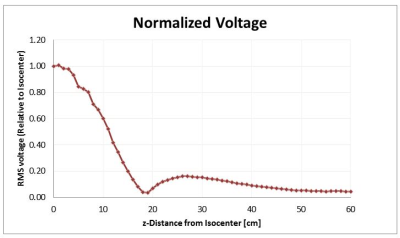 |
164 | Compact 3T MRI for imaging patients with implanted devices: RF and SAR consideration Video Permission Withheld
Yunhong Shu, Nolan Meyer, Lydia Bardwell, Matthew Tarasek, Yihe Hua, Robert Watson, Krzysztof Gorny, Heidi Edmonson, Joel Felmlee, Thomas Foo, Matt Bernstein
Patients with certain implanted devices have been restricted from MRI exams with the whole-body transmit coil due to concern of local heating. A novel compact 3T (C3T) MRI scanner is equipped with an RF coil of larger radius but similar length as a T/R head coil. The purpose of this work is to assess the RF B1 field and E-field of the C3T T/R coil. RF heating risk of head imaging on C3T for patients with implanted devices was evaluated and compared with a commercial T/R head coil.
|
|
4190. 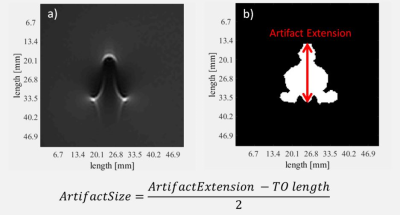 |
165 | Retrospective evaluation of the maximum MR image artifact size according to ASTM F2119 with respect to sequences and slice orientations relevant for MR compatibility testing
Tobias Spronk, Jakob Kreutner, Oliver Kraff, Harald Quick, Gregor Schaefers
This study examines the influence of sequence type, slice orientation and test object orientation on artifact size for medical implants. For this purpose, 79 different objects were evaluated according to ASTM F2119 and the influence of the different parameters was investigated. The evaluation shows that gradient echo sequences more often represented the worst case MR image artifact size as compared to the corresponding spin echo sequences. In addition to this result, the sagittal slice orientation, as compared to the transversal slice orientation, was shown to produce the worst case MR image artifact.
|
|
4191. 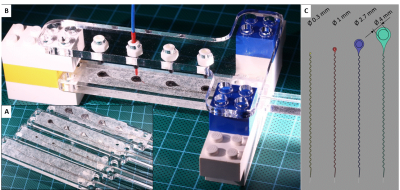 |
166 | Influence of the Electrode Diameter on Radio Frequency-induced Heating in MRI
Johannes Erhardt, Thomas Lottner, Jessica Martinez, Ali Özen, Martin Schuettler, Thomas Stieglitz, Daniel Ennis, Michael Bock
Patients with implanted electrodes often require an MRI exam. This exposes them to the risk of radio-frequency induced heating. In this study heating of implantable electrodes of diameters between 0.3-4mm were evaluated in a 1.5T MRI system. In situ temperature measurements were compared to simulations of the specific absorption rate to assess local and total dissipated power. Measurements showed temperature increases between 0.8-53K. Compared to large electrodes, small electrodes are subject to less dissipated power, but more localized power density. Thus, smaller electrodes might be classified as safe in current certification procedures but may be more likely to burn tissue.
|
|
4192.  |
167 | On the RF Excitation of Overlapping Stents: Electro-optical E-field Measurements
Simon Reiss, Thomas Lottner, Ali Özen, Michael Bock, Andreas Bitzer
In stents, RF-induced heating is mainly associated with the antenna effect that occurs due to the thin and elongated geometry. Heating occurs mainly at the stent tip where a dipole-like E-field pattern is present. However, the E-field pattern and thus the locations of maximum heating change when two stents overlap. Using an optical setup for high-resolution E-field mapping, we provide further insight in the RF excitation of various combinations of stents in different geometric and dielectric configurations.
|
|
4193. 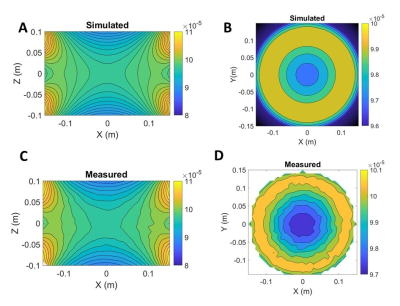 |
168 | Verification and validation of a dB/dt exposure system using a robotic positioning system and induction field probe.
Christine Wawrzyn, Ali Attaran, Jack Hendriks, Ryan Chaddock, Dereck Gignac, William Handler, Blaine Chronik
In this abstract a semi-automated verification and validation protocol for a dB/dt system are presented. A dB/dt coil was simulated, fabricated, and mapped with both a hall probe and dB/dt probe using a positioning robot. All measured values, both DC and dB/dt, matched the expected values over the exposure volume. In addition, dB/dt measurements in air and in saline verify the consistency of the magnetic field in a typical device testing media.
|
|
4194. 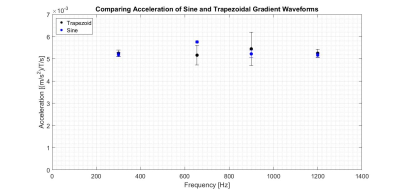 |
169 | Comparison of Device Vibration Induced by Trapezoidal and Sinusoidal Gradient Waveforms
Christine Wawrzyn, William Handler, Colin McCurdy, Blaine Chronik
Gradient induced vibration of a steel disk due to trapezoidal and sinusoidal gradient waveforms was measured at varying frequencies at 3 T. Results show displacement increased monotonically with decreasing frequency but peak acceleration, scaled to the peak gradient field, remained consistent for all experimental conditions. Sinusoidal dB/dt exposure as a function of frequency represents a practical conservative exposure condition for testing dB/dt-induced vibration in conductive devices during MRI.
|
|
4195. 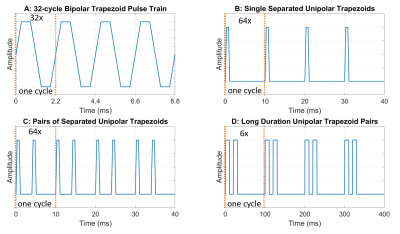 |
170 | Spoiler, Crusher, and Diffusion Gradient Pulses Yield Higher PNS Thresholds than Long Pulse Trains in Head-only Gradient Coils
Colin McCurdy, William Handler, Blaine Chronik
Gradient-induced peripheral nerve stimulation remains a major performance limitation in MRI. Imaging sequences are limited to experimentally-determined thresholds that reduce the likelihood of uncomfortable stimulation in patients, typically using long bipolar trapezoid trains or sinusoidal waveforms. However, common short waveforms found in pulse sequences such as spoilers, crushers, and diffusion pulses could be optimized for higher thresholds. 20 subjects were exposed to representative waveforms for each of these pulse sequences and resulting thresholds indicate that gradient performance increases of between 20 and 40% may be possible.
|
|
4196. 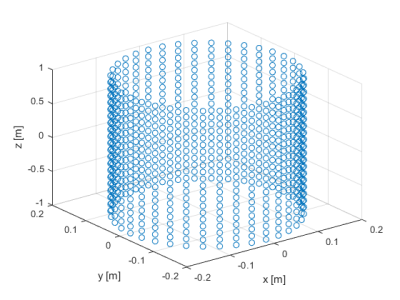 |
171 | The effect of spatial averaging on dB/dt exposure values for implanted medical devices
Christopher Brown, Blaine Chronik
We address to what extent the peak dB/dt exposure for active implantable medical devices (AIMDs) desbribed in ISO 10974:2018(E) differs from the spatial average of dB/dt values for devices relevant for testing with realistic spatial extent.
|
|
4197. 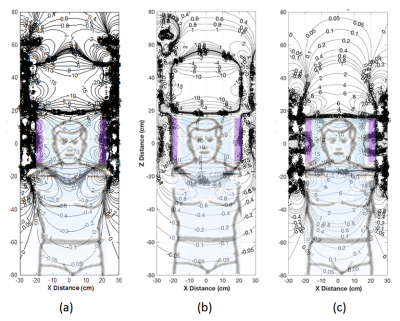 |
172 | Compact 3T MRI for imaging patients with implanted devices: Maximum gradient slew rate considerations
Matt Bernstein, Heidi Edmonson, Yihe Hua, Robert Watson, John Huston III, Joel Felmlee, Thomas Foo, Yunhong Shu
Some implanted devices are labeled as “MR conditional.” Depending on the specific conditions, a desired exam may be precluded, or only allowable under suboptimal conditions. For example, there may be limitations on the gradient slew rate or static field, which are more stringent than the standard regulatory limits in the absence of the implant. Recently, compact 3T (C3T) MR was introduced with high-performance gradients. It is shown that for brain imaging, the safety conditions for some implants may be satisfied at the location of the implant, while the full imaging performance of the C3T is available to image the brain.
|
|
4198. 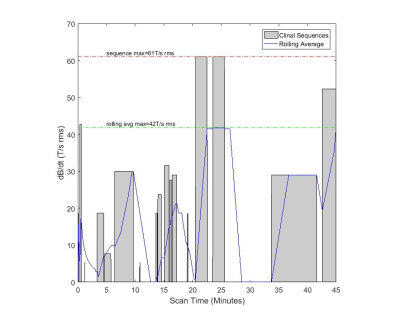 |
173 | Control of Gradient Output for Limiting AIMD Gradient Induced Device Heating
Michael Childers, Shiloh Sison
Control of imaging gradient |dB/dt| rms is desired to limit potential gradient induced heating of medical implants. Current controls for |dB/dt| rms have been implemented on a per sequence basis. In this abstract we show that controlling gradient |dB/dt| rms on a per sequence basis may be overly conservative for certain examinations containing sequences with transient durations of high |dB/dt| rms. As such there is the potential to unnecessarily restrict clinical sequences with acceptable device heating. Alternative means for controlling |dB/dt| rms, such as calculating |dB/dt| rms using a rolling average across sequences, should therefore be considered.
|
|
4199. 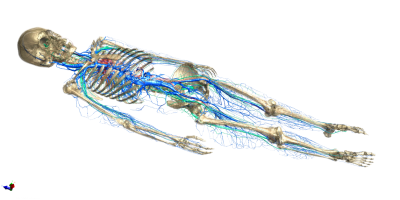 |
174 | Neurostimulation Safety Investigations using Reference, Posable Anatomical Models
Antonino Cassara', Bryn Lloyd, Silvia Farcito, Esra Neufeld, Gisela Hagberg, Niels Kuster
Investigations about the risk of Peripheral Nerve Stimulation (PNS) in magnetic resonance imaging (MRI) are fundamental to mitigate potential safety issues related to the new generation of MRI scanners that use larger Larmor fields and faster/higher gradients. In this study we evaluate the potential of in silico studies for determining the thresholds of PNS when taking into account the anatomical detail and electrophysiology of the peripheral nervous system. We used the latest hybrid electromagnetic (EM) and neuronal simulators combined with our recently released neuro-functionalized Virtual Population model Yoon-sun V4.0. The vision is to utilize such systems for pulse sequence optimization to reduce PNS, the revision of low frequency exposure guidelines, etc..
|
|
4200. 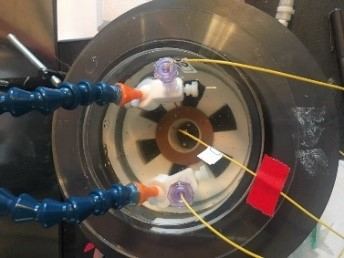 |
175 | Gradient dB/dt Heating Measurements of Copper, Steel, and Titanium Annuli: Assessment of Measurement Repeatability, and Identification of a Potential Reference Standard
Joel Crane, Christine Wawrzyn, William Handler, Blaine Chronik
The purpose of this work is to develop a simple reference standard to be used for gradient-induced heating tests to verify test system operation. A second objective is to provide data on measurement repeatability of heating in these reference objects. Two different dB/dt exposures (270 Hz and 1000 Hz) were used to measure the gradient-induced temperature rise of three MRI compatible metals using a laboratory dB/dt exposure system. Based on the temperature rise, an MRI compatible metal of distinct dimensions and geometry was determined to be most suitable as a dB/dt heating standard across a frequency range of 270-1000 Hz.
|
 Back to Program-at-a-Glance |
Back to Program-at-a-Glance |  Back to Top
Back to Top